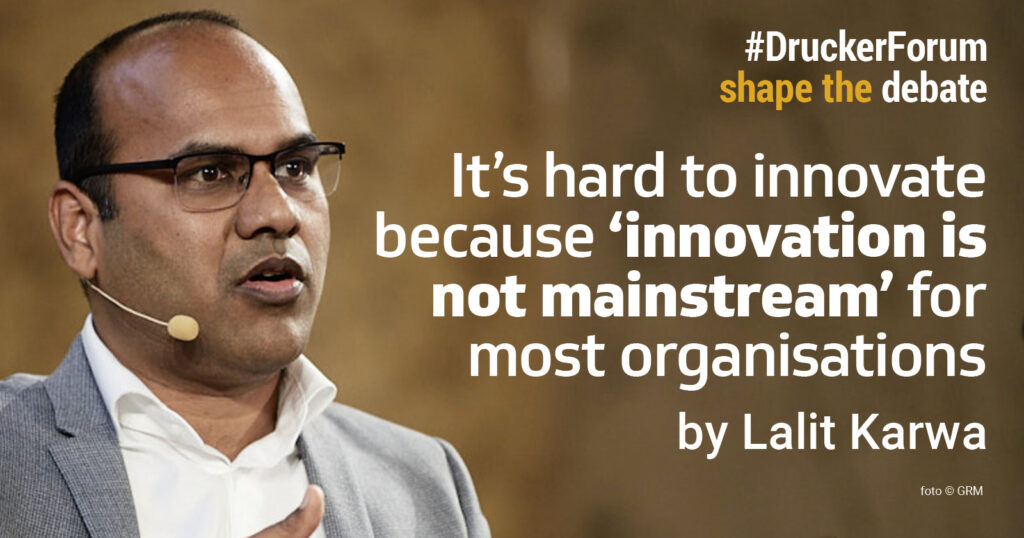
The quest for innovation is great. Business leaders have the vision, drive and ambition to embrace technology. So why do innovation projects so often end in failure?
In times of economic downturn, performance improvement depends more than ever on innovative problem-solving. But how can companies overcome obstacles that block innovation and inhibit value creation? Surprisingly, the most important hurdle is recognising what they are up against in the first place.
Don’t develop solutions until you understand the problems
Some of the greatest minds ever known have given a lot of thought to problem-solving. Albert Einstein said: “If I had an hour to solve a problem, I’d spend 55 minutes thinking about the problem and five minutes thinking about solutions.”
It was this famous quote that framed our discussions on innovation and problem-solving at the recent Peter Drucker Forum in Vienna, Austria. This year, the event was held against a gloomy economic outlook. All of us in attendance – from business, academia and civil society – were looking to identify the fastest and least painful ways to navigate these difficult times.
When I reflect on the many sessions, there was one theme that ran across them all – the need to innovate.
But there was another common thread: almost everyone talking about innovation was struggling to deliver it.
All around the event, voices from Harvard, Stanford and the London Business School were saying the same thing. Something is not working, there’s a blockage in business that stifles innovation and the value creation it brings.
At Tata Consultancy Services (TCS), I have seen these blockages first hand in the organisations we partner with. Our experience of driving innovation agendas with our customers has revealed valuable insights into how to unlock the innovation journey to create exponential value.
Unlocking value through innovation
The first challenge is to identify what value really looks like for an organization. That always begins with the customer. To realise this value, ask which unmet or unarticulated need must be addressed for your customers, or the customers you want to reach.
Once you know what value looks like, the next steps will become clearer. Now search out the problems standing in your way of creating value. This kind of laser focus comes with a major advantage – it will help you discover which problems to tackle.
It’s important that innovation addresses the biggest problems standing in the way of creating value. Everything else can go on the back burner so that you keep the mission-critical list clear and focused. This takes us back to the Einstein quote earlier. Spend time identifying the right problems to solve. There’s nothing worse than throwing time and money at solving problems that won’t create value.
Overcoming the biggest innovation killer
Leaders are frequently frustrated with their organisation’s inability to deliver on innovation, but they often look in the wrong place to identify blockages.
A question I ask senior executives is: With the investments you have already committed to making, can you rate your confidence level in future-proofing your business? In most cases, the responses are not encouraging.
Embedding innovation with future-forward thinking is not a default choice for most leaders. Innovation is not mainstream in most organisations. When innovation is not given priority, new ideas are more likely to be stifled by “corporate antibodies” – people and processes that shut down innovation in the same way our bodies shut down disease. Only by placing innovation at the core of the organisation will this major risk to its successful implementation be managed.
Short-term targets accelerate innovation
A big bang approach to bring innovation mainstream is not recommended. Instead, begin the journey by having the right business problems assigned to hand-picked leaders. These leaders should be early adopters and entrepreneurial thinkers who will push hard to drive this change. Creating a time-constrained environment that triggers unconventional thinking to deliver value is also key for allowing organisations to accelerate this journey. We have seen extraordinary results when we set targets to deliver incremental value in 120-day cycles.
These initial successes will create the right foundation for building a culture of continuous innovation within your organisation, and for bringing innovation mainstream. Thinking big, starting small and moving fast is the only way to accelerate your speed of learning in this journey.
About the author:
Lalit Karwa, Head of TCS Pace, Europe
Lalit has over 20 years’ experience in building new capabilities for organizations keen to respond to shifting customer needs, helping them get more value from their innovation and transformation investments. As the Head of TCS Pace, Lalit puts an emphasis on solving business problems using technology enablers: through digital re-imagination/transformation, strategic planning, defining roadmaps and modelling the execution.


Great read Lalit!
I agree that innovation needs to be mainstreamed asap. Organizations still have separate budgets for innovation as opposed to practicing it in “innovation by design” methods. I personally think innovation can be amplified only when it walks out of an innovation lab and becomes daily business for an organization bottop-up.
Great stuff. Innovation should be at the heart of the organisation and it’s activities. Not all problems solved create value hence, problems must be studied. Don’t be consumed with taking giant leaps especially at the beginning – think big, start small and act fast. So many take-aways!
I simply wanted to send you a quick note to let you know that I’m very new to blogging and that I genuinely enjoy your page. It is very likely that I will add this post to my bookmarks on your blog. Your articles and testimonials are unquestionably of the highest quality. Thank you for letting me know about your website.